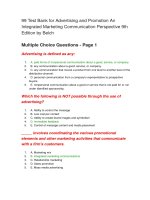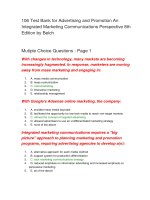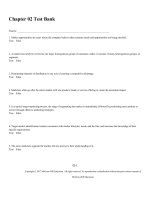Lecture Advertising and promotion: An integrated marketing communications perspective (10/e): Chapter 4 - George E. Belch, Michael A. Belch
Bạn đang xem bản rút gọn của tài liệu. Xem và tải ngay bản đầy đủ của tài liệu tại đây (924.29 KB, 20 trang )
Chapter 4
Perspectives
on
Consumer
Behavior
Copyright © 2015 McGraw-Hill Education. All rights reserved. No reproduction or distribution without the prior written consent of
McGraw-Hill Education.
Figure 4.1 A Basic Model of Consumer
Decision Making
Copyright © 2015 McGraw-Hill Education. All rights reserved. No reproduction or distribution without the prior written consent of
McGraw-Hill Education.
2
Problem Recognition
Consumer perceives a need and gets motivated to
solve the problem
Caused by a difference between consumer’s ideal
state and actual state
Sources
Out of stock
Dissatisfaction, new needs or wants
New products, related products or purchases
Marketerinduced problem recognition
Copyright © 2015 McGraw-Hill Education. All rights reserved. No reproduction or distribution without the prior written consent of
McGraw-Hill Education.
3
Figure 4.2 Maslow’s Hierarchy of Needs
Selfactualization
needs
(self-development
and realization)
Esteem needs
(self-esteem,
recognition, status)
Social needs
(sense of belonging, love)
Safety needs
(security, protection)
Physiological needs
(hunger, thirst)
Copyright © 2015 McGraw-Hill Education. All rights reserved. No reproduction or distribution without the prior written consent of
McGraw-Hill Education.
4
Psychoanalytic Theory
Influenced modern psychology and explanations of
motivation and personality
Applied to the study of consumer behavior
Deep motives can only be determined by probing
the subconscious
Copyright © 2015 McGraw-Hill Education. All rights reserved. No reproduction or distribution without the prior written consent of
McGraw-Hill Education.
5
Figure 4.3 Some of the Marketing Research
Methods Used to Probe the Mind of the Consumer
Copyright © 2015 McGraw-Hill Education. All rights reserved. No reproduction or distribution without the prior written consent of
McGraw-Hill Education.
6
Perception Processes
Sensation
• Immediate, direct response of the senses to a stimulus
Selecting information
• Internal psychological factors determine what one focuses on
and/or ignores
Interpreting the information
• Organizing, and categorizing information is influenced by:
• Internal psychological factors
• The nature of the stimulus
Selective perception
• Results from the high number and complexity of the marketing
stimuli a person is exposed to
Copyright © 2015 McGraw-Hill Education. All rights reserved. No reproduction or distribution without the prior written consent of
McGraw-Hill Education.
7
Selective Perception Process
Selective exposure
• Consumers choose whether or not to make themselves available
to information
Selective attention
• Consumer chooses to focus attention on certain stimuli while
excluding others
Selective comprehension
• Consumers interpret information on the basis of their own
attitudes, beliefs, motives, and experiences
Selective retention
• Consumers do not remember all the information they see, hear, or
read even after attending to and comprehending it
• Mnemonics: Symbols, rhymes, associations, and images that
assist in the learning and memory process
Copyright © 2015 McGraw-Hill Education. All rights reserved. No reproduction or distribution without the prior written consent of
McGraw-Hill Education.
8
Alternative Evaluation
Comparing the brands one has identified as being
capable of:
Solving the consumption problem
Satisfying the needs or motives that initiated the
decision process
Evoked set Subset of all the brands of which the
consumer is aware
Size depends on the:
Importance of the purchase
Time and energy spent comparing alternatives
Copyright © 2015 McGraw-Hill Education. All rights reserved. No reproduction or distribution without the prior written consent of
McGraw-Hill Education.
9
Evaluative Criteria and Consequences
Evaluative criteria: Dimensions or attributes of a
product that are used to compare different
alternatives
Objective or subjective
Viewed as product or service attributes
Functional consequences: Concrete outcomes of
product or service usage
Tangible and directly experienced by consumers
Copyright © 2015 McGraw-Hill Education. All rights reserved. No reproduction or distribution without the prior written consent of
10
McGraw-Hill Education.
Evaluative Criteria and Consequences
Psychosocial consequences: Abstract outcomes
that are more intangible, subjective, and personal
Subprocesses
Process by which consumer attitudes are created,
reinforced, and changed
Decision rules or integration strategies used to
compare brands and make purchase decisions
Copyright © 2015 McGraw-Hill Education. All rights reserved. No reproduction or distribution without the prior written consent of
11
McGraw-Hill Education.
Attitudes
Learned predispositions to respond to an object
Theoretically summarize a consumer’s evaluation
of an object
Represent positive or negative feelings and
behavioral tendencies
Copyright © 2015 McGraw-Hill Education. All rights reserved. No reproduction or distribution without the prior written consent of
12
McGraw-Hill Education.
Attitude Change Strategies
Changing the strength or belief rating of a brand on
an important attribute
Changing consumers’ perceptions of the
importance or value of an attribute
Adding a new attribute to the attitude formation
process
Changing perceptions of belief ratings for a
competing brand
Copyright © 2015 McGraw-Hill Education. All rights reserved. No reproduction or distribution without the prior written consent of
13
McGraw-Hill Education.
The Decision Process
Copyright © 2015 McGraw-Hill Education. All rights reserved. No reproduction or distribution without the prior written consent of
14
McGraw-Hill Education.
Figure 4.6 The Classical
Conditioning Process
Copyright © 2015 McGraw-Hill Education. All rights reserved. No reproduction or distribution without the prior written consent of
15
McGraw-Hill Education.
Figure 4.7 Instrumental
Conditioning in Marketing
Copyright © 2015 McGraw-Hill Education. All rights reserved. No reproduction or distribution without the prior written consent of
16
McGraw-Hill Education.
Figure 4.8 Application of Shaping
Procedures in Marketing
Copyright © 2015 McGraw-Hill Education. All rights reserved. No reproduction or distribution without the prior written consent of
17
McGraw-Hill Education.
Figure 4.9 The Cognitive Learning Process
Copyright © 2015 McGraw-Hill Education. All rights reserved. No reproduction or distribution without the prior written consent of
18
McGraw-Hill Education.
Environmental Influences on Consumer
Behavior
Culture
• Complexity of learned meanings, values, norms, and
customs shared by members of a society
Subcultures
• Smaller segments within a culture, whose beliefs, values,
norms, and patterns of behavior set them apart from the
larger cultural mainstream
Social class
• Homogeneous divisions in a society into which people
sharing similar lifestyles, values, norms, interests, and
behaviors can be grouped
Copyright © 2015 McGraw-Hill Education. All rights reserved. No reproduction or distribution without the prior written consent of
19
McGraw-Hill Education.
Environmental Influences on Consumer
Behavior
Reference group
• Group whose presumed perspectives or values
are being used by an individual as the basis for his
or her judgments, opinions, and actions
Situational determinants
• Specific situation in which consumers plan to use
the product or brand directly affects their
perceptions, preferences, and purchase behaviors
• Types - Usage, purchase, and communications
situation
Copyright © 2015 McGraw-Hill Education. All rights reserved. No reproduction or distribution without the prior written consent of
20
McGraw-Hill Education.









